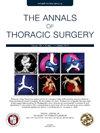Predictors of Discharge With Supplemental Oxygen After Lobectomy for Lung Cancer
IF 3.6
2区 医学
Q1 CARDIAC & CARDIOVASCULAR SYSTEMS
引用次数: 0
Abstract
Background
Before lung cancer resection, patients inquire about dyspnea and the potential need for supplemental oxygen. The objective of this study was to identify predictors of discharge with supplemental oxygen for patients undergoing lobectomy for lung cancer.
Methods
Using The Society of Thoracic Surgeons General Thoracic Surgery Database, study investigators conducted a retrospective cohort study of patients who underwent lobectomy for lung cancer from July 2018 to December 2021. Multivariable logistic regression was used to determine the adjusted association of pulmonary function with discharge on supplemental oxygen and identify independent predictors of discharge with supplemental oxygen. Pulmonary function was modeled as the minimum of either predicted postoperative forced expiratory volume in 1 second or predicted postoperative diffusing capacity of lung for carbon monoxide.
Results
Overall, 2100 (8.4%) patients who underwent lobectomy were discharged with supplemental oxygen. Those patients with a minimum of either predicted postoperative forced expiratory volume in 1 second or predicted postoperative diffusing capacity of lung for carbon monoxide ≤60% had a progressively increased risk of discharge with supplemental oxygen than patients with minimum function >60%. The 2 strongest predictors of discharge with supplemental oxygen were increasing body mass index (25-29 kg/m2: adjusted odds ratio [aOR], 1.38; 95% CI, 1.21-1.57; 30-39 kg/m2: aOR, 2.14; 95% CI, 1.88-2.45; ≥40 kg/m2: aOR, 3.51; 95% CI, 2.79-4.39; reference, 18.5-24 kg/m2) and former (aOR, 2.04; 95% CI, 1.67-2.52) or current (aOR, 2.61; 95% CI, 2.10-3.26) smoking status (reference, never smoker).
Conclusions
Of those patients who underwent lobectomy for lung cancer, 8.4% were discharged with supplemental oxygen. The study identified preoperative independent predictors of discharge with supplemental oxygen that may be useful during shared decision-making discussions of treatment options for lung cancer and setting expectations with patients.
肺癌肺叶切除术后辅助供氧出院的预测因素
背景:肺癌切除术前,患者会询问有关呼吸困难和可能需要补充氧气的问题。我们的目的是确定肺癌肺叶切除术患者出院时补充氧气的预测因素:利用胸外科医师协会普通胸外科数据库,我们对 2018 年 7 月至 2021 年 12 月期间接受肺叶切除术的肺癌患者进行了一项回顾性队列研究。我们使用多变量逻辑回归来确定肺功能与补充氧气出院的调整关联,并确定补充氧气出院的独立预测因素。肺功能以 ppoFEV1 或 ppoDLCO 的最小值建模:共有 2100 名(8.4%)接受肺叶切除术的患者在出院时使用了辅助供氧。ppoFEV1或ppoDLCO最低值≤60%的患者与最低功能>60%的患者相比,补充氧气出院的风险逐渐增加。补充氧气出院的两个最强预测因素是体重指数增加(25-29 aOR 1.38,95%CI 1.21-1.57;30-39 aOR 2.14,95%CI 1.88-2.45;≥40 aOR 3.51,95%CI 2.79-4.39,参考值 18.5-24)以及曾经(aOR 2.04,95%CI 1.67-2.52)和目前(aOR 2.61,95%CI 2.10-3.26)吸烟状态(参考值从不吸烟):结论:在接受肺叶切除术的肺癌患者中,有 8.4% 的人出院时需要补充氧气。我们发现了术前辅助吸氧出院的独立预测因素,这些因素可能有助于就肺癌治疗方案进行共同决策讨论,并与患者共同设定期望值。
本文章由计算机程序翻译,如有差异,请以英文原文为准。
求助全文
约1分钟内获得全文
求助全文
来源期刊

Annals of Thoracic Surgery
医学-呼吸系统
CiteScore
6.40
自引率
13.00%
发文量
1235
审稿时长
42 days
期刊介绍:
The mission of The Annals of Thoracic Surgery is to promote scholarship in cardiothoracic surgery patient care, clinical practice, research, education, and policy. As the official journal of two of the largest American associations in its specialty, this leading monthly enjoys outstanding editorial leadership and maintains rigorous selection standards.
The Annals of Thoracic Surgery features:
• Full-length original articles on clinical advances, current surgical methods, and controversial topics and techniques
• New Technology articles
• Case reports
• "How-to-do-it" features
• Reviews of current literature
• Supplements on symposia
• Commentary pieces and correspondence
• CME
• Online-only case reports, "how-to-do-its", and images in cardiothoracic surgery.
An authoritative, clinically oriented, comprehensive resource, The Annals of Thoracic Surgery is committed to providing a place for all thoracic surgeons to relate experiences which will help improve patient care.
 求助内容:
求助内容: 应助结果提醒方式:
应助结果提醒方式:


